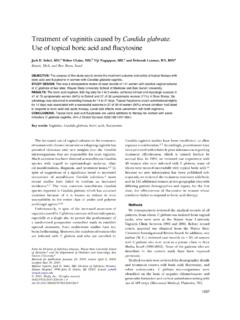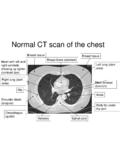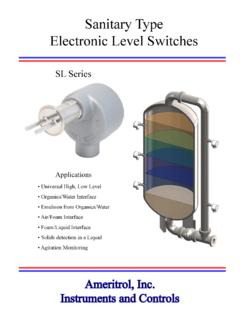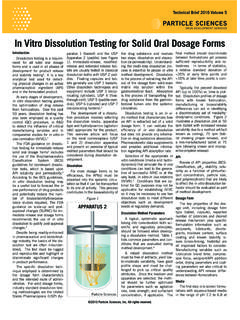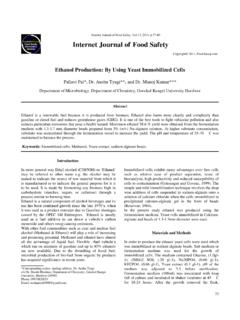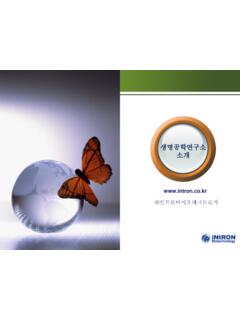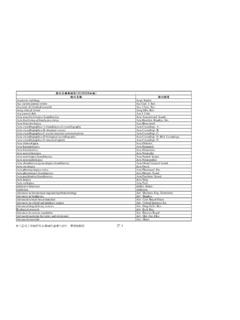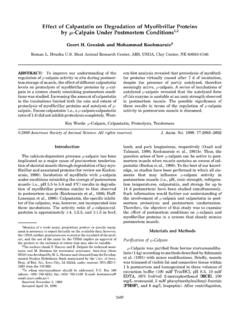Transcription of Identification of fungal microorganisms by MALDI …
1 Research review paperIdentification of fungal microorganisms by MALDI -TOFmass spectrometryJana Chalupov a,1,MartinRausa,1,MichaelaSedl ov b,Marek ebelaa, aDepartment of Protein Biochemistry and Proteomics, Centre of the Region Han for Biotechnological and Agricultural Research, Faculty of Science,Palack University, lechtitel 11, CZ-783 71 Olomouc, Czech RepublicbDepartment of Botany, Faculty of Science, Palack University, lechtitel 11, CZ-783 71 Olomouc, Czech Republicabstractarticle infoAvailable online xxxxKeywords:BiotypingFungiIdentificatio nIntact cell/spore mass spectrometryMALDIM ildewPeptideProteinTaxonomyYeastsMatrix- assisted laser desorption/ionization time-of-flight mass spectrometry ( MALDI -TOF MS) has emerged as areliable tool for fast Identification and classification of microorganisms .
2 In this regard, it represents a strong chal-lenge to microscopic and molecular biology methods. Nowadays, commercial MALDI systems are accessible forbiological research work as well as for diagnostic applications in clinical medicine, biotechnology and are employed namely in bacterial biotyping but numerous experimental strategies have also been devel-oped for the analysis of fungi, which is the topic of the present review. Members of many fungal genera suchasAspergillus,Fusarium,Penicilliumor Trichodermaand also various yeasts from clinical samples ( ) have been successfully identified by MALDI -TOF MS. However, there is no versatile method for fungicurrently available even though the use of only a limited number of matrix compounds has been reported.
3 Eitherintact cell/spore MALDI -TOF MS is chosen or an extraction of surface proteins is performed and then the resultingextract is measured. Biotrophic fungal phytopathogens can be identified via a direct acquisition of MALDI -TOFmass spectra from infected plant organs contaminated by fungal spores. Mass spectrometric peptide/proteinprofiles of fungi display peaks in them/zregion of 1000 20 000, where a unique set of biomarker ions may ap-pear facilitating a differentiation of samples at the level of genus, species or strain. This is done with the help of aprocessing software and spectral database of reference strains, which should preferably be constructed under thesame standardized experimental conditions. 2013 Published by Elsevier 02.
4 Biological methods of fungal strains 03. 04. 05. MALDI -TOF MS analysis 06. MALDI -TOF MS analysis ofPenicillium, 07. MALDI -TOF MS analysis 08. 09. 010. 0 Biotechnology Advances xxx (2013) xxx xxxAbbreviations:AFST, antifungal susceptibility testing; CA, caffeic acid; CHCA, -cyano-4-hydroxycinnamic acid; DHB, 2,5-dihydroxybenzoic acid; FA, ferulic acid; HABA, [2-(4-hydroxyphenylazo)]benzoic acid; IC/IS, intact cell or intact spore; IGS, intergenic spacer; ITS, internally transcribed spacer; LSU, large subunit; MALDI -TOF, matrix-assistedlaser desorption/ionization time-of-flight; MS, mass spectrometry; SA, sinapinic acid; SSU, small subunit; TFA, trifluoroacetic acid. Corresponding author. Tel.: +420 585634927; fax: +420 ebela).
5 1 Both authors contributed ; No of Pages 120734-9750/$ see front matter 2013 Published by Elsevier lists available atScienceDirectBiotechnology Advancesjournal homepage: cite this article as: Chalupov J, et al, Identification of fungal microorganisms by MALDI -TOF mass spectrometry, Biotechnol Adv (2013), IntroductionMicrofungi are described as a group of eukaryotic organisms such asmolds, rusts and yeasts plus fungi-like microorganisms (belonging tothe taxonomic ranks Protista, Chromista and Myxomycota), which areno longer classified in the kingdom Fungi. A broad spectrum of these mi-croorganisms with miscellaneous ecology, physiology and morphologycovers important producers of enzymes, organic acids, pharmaceuticals,alcohols or antibiotics.
6 Many of them also synthesize harmful toxins caus-ing human and animal diseases. As natural recyclers of organic plant ma-terial, fungal plant pathogens have a negative impact on agriculture(Bennett, 1998; Cannon and Sutton, 2004; Santos et al., 2010). Studieson fungal organisms are complicated because of an inadequate compre-hension of the whole fungal speciation connected with population biolo-gy, ecology, evolution and phylogeny. As regards to the detection ofhuman/animal and plant mycoses and Identification of the causal agents,standard biological methods become insufficient in many cases. They areoften time consuming and tend to the advent of mass spectrometry (MS), numerous identifica-tion methods for microorganisms based on profiling of cell surfaceproteins have been described.
7 They include namely the intact cell orintact spore mass spectrometry (IC/IS MS), but also rely on an initialextraction of proteins by acidified solvents (Welham et al., 2000)orwiththehelpofabeadbeatingpriortot heMSanalysis(Hetticket al., 2008a,2008b). MS measurements with bacterial cells evolvedhand in hand with the development of MS itself (Meuzelaar andKistemaker, 1973). Matrix-assisted laser desorption/ionization time-of-flight mass spectrometry ( MALDI -TOF MS) has emerged as one ofthe most reliable tools for fast and easy Identification , differentiationand classification of microorganisms . IC/IS MALDI -TOF MS operateswith unique mass spectrometric profiles (fingerprints) acquired by thedesorption of specific peptide/protein biomarkers from the cell/sporesurface of a particular pathogen (Fenselau and Demirev, 2001).
8 Basedon results and experience gained in bacterial Identification , IC/ISMALDI-TOF MS has also been introduced for a differentiation of micro-scopic fungi. Contrary to bacteria, fungal cells are larger in size and theircell wall is more rigid. It is usually based on glucans and chitin, rarelyon glucans and cellulose (in the distinct phylogenetic lineage offungi-like Oomycota). Mannoproteins are also major cell wall com-ponents, especially in yeasts (Carlile et al., 2001). Taking this intoconsideration, modified approaches had to be developed as regardsto the procedure of sample preparation, selection of a proper matrixcompound, sample deposition techniques review article describing characterization offilamentous fungi byMALDI-TOF MS appeared in 2010 (Santos et al.)
9 , 2010) but the text natu-rally does not cover yeast analysis. More recently,Havlicek et al. (2013)summarized current trends in MS-based microbial diagnostics with a spe-cial focus on the instrumentation (fungi were included but only marginal-ly). In 2013, two comprehensive reviews appeared (Clark et al., 2013;Posteraro et al., 2013), which emphasized the use of MALDI -TOF MS forthe analysis of fungi in clinical microbiology laboratories. However,other applications than those related to medicine were not present review deals with MALDI -based Identification of fungi in var-ious branches of science and diagnostics. Standard biological methods ofdetermining fungal species are briefly discussed together with their limi-tations, which provide a space to befilled up with mass spectrometricstrategies.
10 There arefirst attempts of fungal Identification mentioned to-gether with a further progress illustrated on has been paid to potential applications in biotechnology, medi-cine and Biological methods of fungal strains identificationThe main goal in allfields of diagnostics is to identify the origin of ahuman, animal or plant disease in such a way, which is fast, reliable andeffective. Basic methods for the detection of fungal pathogens are basedon host specificity, disease symptoms and microscopic characters. Al-though the host specificity and disease symptoms can preliminaryhelp to estimate a causal agent, signs usually change during the diseaseprogression and thus they can give unclear information (Carlile et al.,2001; Doohan, 2005). Because of considerable variability in fungalmorphology, microscopy still remains an indispensable tool for identi-fying individual species.

